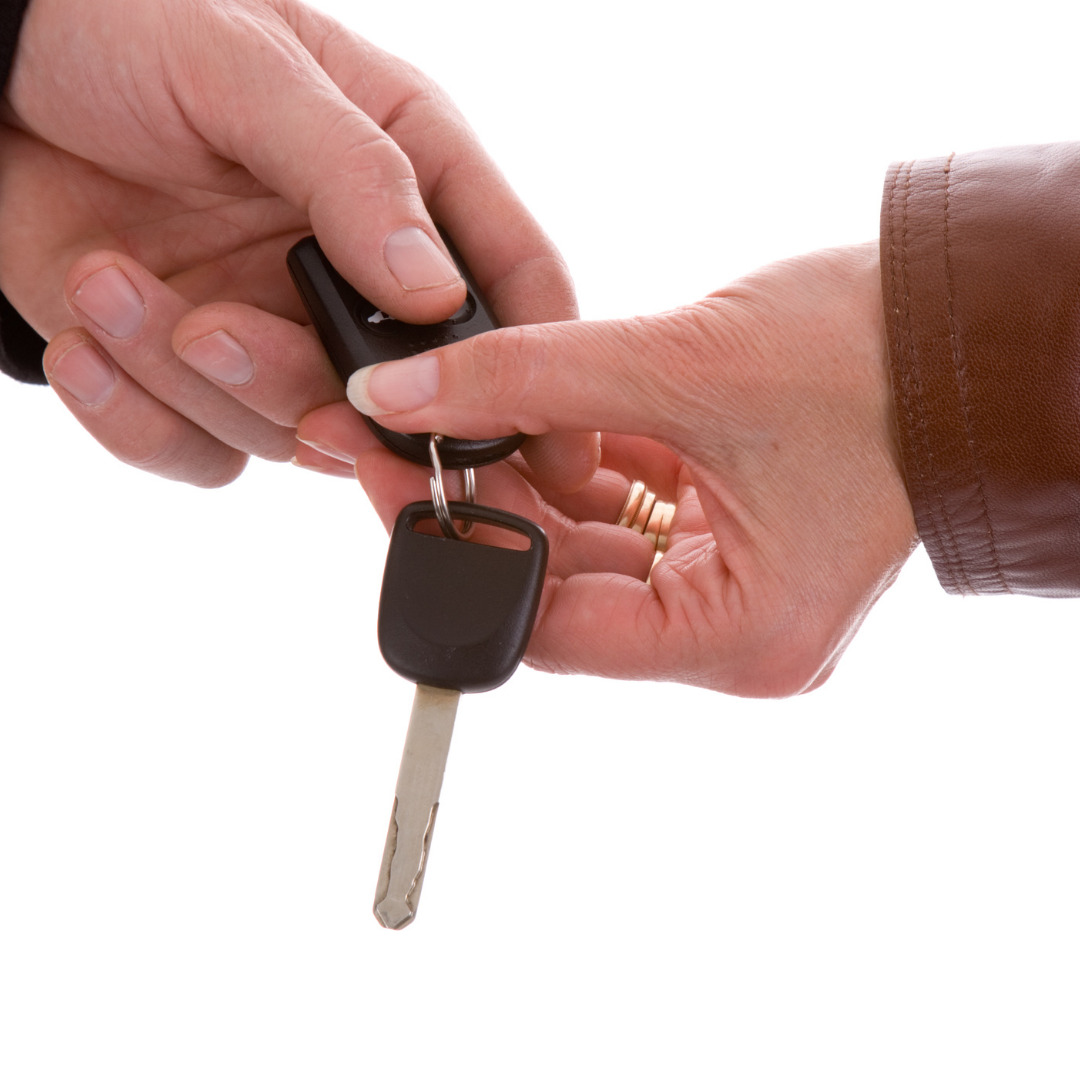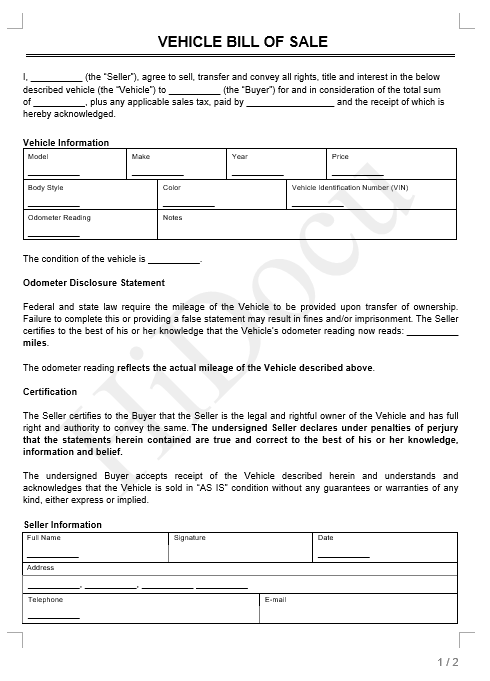Vehicle Bill of Sale
EMC Consultancy
A bill of sale is a legal document used to transfer ownership of an item from one person to another. Bill of sale forms are similar to retail receipts, but are used to record the sale or transfer of valuable items like cars.
Depending on what you’re buying or selling, you may need to use one of the following types of bill of sale:
• Vehicle Bill of Sale
• Boat Bill of Sale
• Firearm Bill of Sale
• Horse Bill of Sale
Using a bill of sale protects the buyer and the seller from future legal disputes over the item’s condition or ownership. Most states require a completed bill of sale to register a vehicle, and many recommend using a bill of sale if you are buying or selling any item over $500.
You’ll also see a bill of sale referred to as a purchase agreement, a proof of sale, a proof of purchase, a sales receipt, a sales slip, and an as-is bill of sale.
€49,95
Table of Contents
1. Key Terms
2. How to Use a Bill of Sale Form
3. Bill of Sale Frequently Asked Questions (FAQs)
4. Bill of Sale Template
Key Terms
Whether you’re buying or selling an item, it’s important to know the following legal terms in order to correctly fill out your bill of sale form.
- Buyer — The person who is purchasing the item. Also known as the purchaser.
- Seller — The person (or party) that is selling the item.
- As-is — “As-is” means that the item is sold in its current condition at the time of sale, and that the buyer accepts any faults that are present.
- Warranty Provision — A written guarantee that the seller will repair or replace the item if there are any defects over a specified period of time. If you don’t include a warranty provision in your bill of sale, the item is sold “as-is.”
- Certificate of Title — Separate paperwork that states who the legal owner of an item is. If applicable, this should be transferred when completing the sale. Note that a bill of sale proves the transaction took place, but it’s not always proof of ownership.
- Sales Tax — A tax the government imposes on the sale of goods. This tax varies by state and a bill of sale helps determine how much you need to pay.
- Notarization — A process that authenticates a legal document and the signatures of the parties involved. Not all states require a bill of sale to be notarized.
- Notary Public — A state-appointed representative who notarizes documents.
- Promissory Note — A promissory note is a document that promises someone will pay an amount of money. You should include one with your bill of sale if the transfer requires the buyer take out a loan instead of paying in full.
- Odometer Reading — A section of an auto bill of sale where you record the vehicle’s mileage at the time of sale.
- Vehicle Identification Number (VIN) — A unique identification code for a motor vehicle that must be included in a car bill of sale.
How to Use a Bill of Sale Form
Buyers and sellers can follow the simple steps below to fill out their bill of sale form and record the transfer or sale of an item.
The seller typically provides the bill of sale, but if you’re the buyer, you may wish to bring your own form just in case. Remember to check individual state requirements before you create your form, as some states have different requirements for certain items.
Complete the bill of sale in full and accurately describe the item being transferred or sold. If the seller withholds any information about the item, the bill of sale may be null and void (not legally valid).
Both parties should keep a copy of the signed bill of sale for their records.
Step 1 – Negotiate the Terms of the Sale
Before filling out a bill of sale, the buyer and seller should confirm the item’s condition, and agree to its sale.
At this stage, both parties agree on a payment method and any special conditions of the sale, such as a warranty or financing. If the buyer chooses to pay in cash, the amount needs to be paid in full at the time of the sale. Financing is commonly handled separately through a bank.
When a bill of sale includes a warranty, it must explain clearly what damage and repairs the guarantee covers, and for how long. If the bill of sale does not include a warranty, the item is sold “as-is.” Therefore, it’s important for the buyer to check the item thoroughly and ask any questions before the sale is completed and the form is signed.
Step 2 – Fill Out the Bill of Sale With the Required Information
Once the terms of the sale have been agreed, the buyer and seller should complete the bill of sale form. Be careful as you fill it out, as both parties’ handwriting must be legible for the bill of sale to be valid.
A bill of sale includes the following sections that must be completed:
Seller and Buyer Information
Both the seller and buyer need to write their contact details, including their full name, street address, city, state, zip code, telephone number, and email address.
Item Information and Price
This section will be different depending on the type of item you are buying or selling, but you’ll always need to write the sale price and describe the item’s condition. Noting any faults or damage in detail here will help you avoid disputes later.
If you are completing a vehicle bill of sale, you’ll need to fill out the following information:
- model
- make
- year
- body style
- color
Other items have different sections. For example, boats require manufacturer, vessel type, and size. Horses require breed, sex, and name of sire.
Additional Information [For Cars]
If you’re completing an auto bill of sale, you’ll need to write the odometer reading and vehicle identification number (VIN). The odometer reading is the current mileage at the time of sale. The VIN is usually printed on the windshield or inside the door.
Step 3 – Complete the Sale
Once you’ve filled out all the information, both parties need to check the form, and then sign and date it. Most states don’t require you to notarize your bill of sale to make it valid.
To complete the sale, the seller collects payment, and hands over the certificate of title (if applicable). If you’ve bought a vehicle, you’ll need to register it at the department of Motor Vehicles (DMV) and pay sales tax.
Bill of Sale Frequently Asked Questions (FAQs)
What is a bill of sale?
A bill of sale is a legal document that is used to transfer ownership of a valuable item from one person or party to another. Bill of sale forms can be used to sell goods, exchange them, or give them as gifts.
What does “as is” mean in a bill of sale?
In a bill of sale, “as-is” means the item is being sold in its current condition without a warranty. “As-is” protects the seller from ever needing to offer a refund, because it states that the item was sold with the buyer aware of its condition and that they are buying it as it is.
When should I use a bill of sale?
You should use a bill of sale when transferring any valuable item to a new owner. Many states require you to provide a signed bill of sale as proof of purchase when registering certain items.
You can use a bill of sale to transfer ownership of items such as the following:
- Vehicles (cars, RVs, motorcycles, trailers, campers)
- Watercraft (boats, jet skis)
- Personal property (bicycles, furniture, jewelry)
- Animals (horses, dogs, cats, livestock)
- Equipment (tools, exercise equipment)
- Firearms
What information should be included in a bill of sale?
The following information should be included in a bill of sale:
- Names, addresses, contact details, and signatures of the buyer and seller
- The date of the sale and the agreed price
- Relevant information about the item, such as the manufacturer, model, and condition
- For cars: odometer reading and vehicle identification number (VIN)
What happens if I don’t use a bill of sale?
If you don’t use a bill of sale, you could encounter legal issues after selling an item. Bills of sale are important to prove a cash sale took place, and they protect both the buyer and seller in the event of a dispute.
For example, without a bill of sale to record the transaction, you cannot legally prove that an item was sold. Therefore, the seller may still be responsible for violations the purchaser commits after the item is transferred (such as speeding tickets in the case of a vehicle).
Specificaties: Vehicle Bill of Sale
|
Informatie verkoper
- Shopnaam: EMC Consultancy
- Verkoper EMC Consultancy
-
Adres:
Groenstraat 27
4841BA Breda - Nog geen beoordelingen!

























